Collage and Photography: Naruki Oshima’s New Series ‘haptic green’ (Part 2)
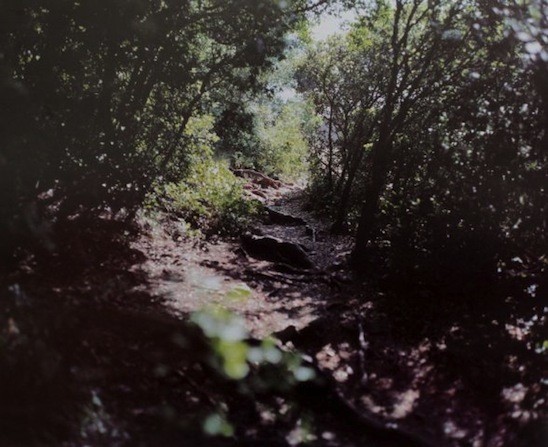
Risaku Suzuki Mont Sainte Victoire NZP-10 (2001), type C print, 40.7 x 50.8 cm. Courtesy Gallery Koyanagi.
Naruki Oshima’s “haptic green” is a series of collages each made by joining together hundreds of photographic parts shot while adjusting the camera’s focal length to form a single scene. At this point I would like to cite as a reference Risaku Suzuki. This is because like “haptic green,” series by Suzuki such as “Mont Sainte Victoire” and “Sakura” are experiments in “gazing intently” at the subject, or in other words in creating perceptual space in the form of “depth,” as well as in how to express this space using photographs, a medium based on transparent layers.(1) Given this, perhaps we could refer to Suzuki’s cherry blossoms as “haptic pink”?
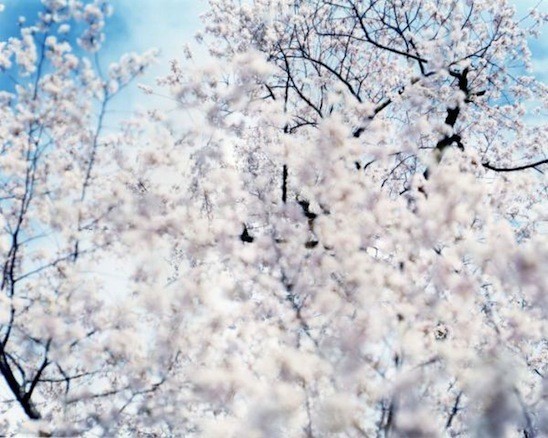
Risaku Suzuki SAKURA N-19 (2002), type C print, 120 x 155 cm. Courtesy Gallery Koyanagi.
In the creation of spatiality in the form of “depth,” we are not talking about depth with a perspectival vanishing point, but rather the depth referred to by Maurice Merleau-Ponty in Phenomenology of Perception when he wrote, “The relations of sentient to sensible are comparable with those of the sleeper to his slumber.”(2) Depth as “slumber,” or “primordial depth,” is “the thickness of the medium,” at which point “[c]olors are no longer condensed into surface colors, but are diffused round about objects and become atmospheric colors.”(3) But is it really possible to express such atmospheric colors, diffused in a preexistentially differentiated state, using the medium of photography, which is essentially based entirely on transparent layers, and as such requires dividing space into transparent layers? According to Merleau-Ponty, “We say a priori that no experience is atomic, that all sensory experience presupposes a certain field, hence co-existences…”(4) However, can photography, which must have a “point” in the form of a focal point and necessarily presupposes a distance in the form of the focal distance whenever the lens is directed at a subject, express such a co-existing “depth of subject”? Merleau-Ponty goes on to describe the experience of “feeling” in general as absorption in mysteriousness. “As I contemplate the blue of the sky, I am not set over against it as an acosmic subject; I do not possess it in thought … I abandon myself to it and plunge into its mystery, it ‘thinks itself within me.’ … [M]y consciousness is saturated with this limitless blue.”(5)
The thing that distinguishes this series by Naruki Oshima and Risaku Suzuki’s “Mont Sainte Victoire” and “Sakura” is differential focusing. It is this that enables them to achieve both blur and focus. Beautiful blurring appears to express the atmospheric colors diffused around objects, while at the same time the focus is adjusted to a certain focal distance, producing transparent layers and dividing the space into layers front and back. In Suzuki’s case, these layers are often set at a depth around the middle of the photographic space, which is to say the blurred space is divided up in front of and behind the layers in which the focus is clear. To take a photograph is to divide the consecutive “depths” of space with a single layer. This is none other than the rejection of “the thickness of the medium.” “Mont Sainte Victoire” is a series of photographs on the impotency of photography. Suzuki’s photographs make beautiful blurring shine (plus), but at the same time their sympathy with the “blue of the sky,” or in other words the undifferentiated world, describes clearly the impossibility of photography, that photography is the abandonment of atmospheric colors (minus). Out of this unobtrusive plus + minus = zero methodology emerges a restrained, sober lyricism. The mechanism peculiar to photography that enables one to capture space at the desired depth by manipulating the depth of field and focal distance is also a mechanism that cuts into pieces the physical absorption integrated with the scene à la Merleau-Ponty. Along with this modernist lyrical restraint, Suzuki introduces into his absorptive scenes abandonment in the form of a single transparent layer, affirming that photography is both a medium of disillusionment and a medium of distance.
In contrast, for Naruki Oshima photography is a medium for the expression above all else of Merleau-Ponty’s absorption, or what he refers to as “primordial depth” and “atmospheric colors.” In fact one could probably say that if Risaku Suzuki is above all a photographer, then Naruki Oshima is above all an artist. The word “haptic” refers to “visual and tactile sensations” that involve none other than touching a scene with the eyes, grasping a scene with the eyes. This concept, which derives from Alois Riegl, was introduced to describe the transitional nature of late Roman art from ‘”tactile” classical art to “optical” pre-modern art. For Oshima, to the extent that it involves seeking in photographic expression “visual and tactile sensations” found in art history, using photography to achieve this contrary to its essential mechanism but without denying this mechanism is problematic. And herein lies the significance of Oshima’s use of digital photography.”(6) By using this mechanism excessively rather than denying it, he is seeking to nullify it. Indeed, compared to the lyrical experience described by Merleau-Ponty, this process is a rather utilitarian, even violent, act. This is because when he grasps a scene with his eyes, Oshima cuts it into more than 200 pieces with layers of different depth. He then combines these pieces on a computer and digitally removes any trace of the joins between them, producing images in which disparate focal lengths (ie, disparate layers) are scattered across the picture plane, images that are literally dazzling. Because viewers can see 200 layers simultaneously, they see no layer, and from this arises a peculiar kind of absorption. Unlike analog photography in which it is impossible to deny layers, Oshima’s photography produces an excess of layers, and it is this that enables him to compose the “haptic” absorption that was impossible to compose with analog photography.
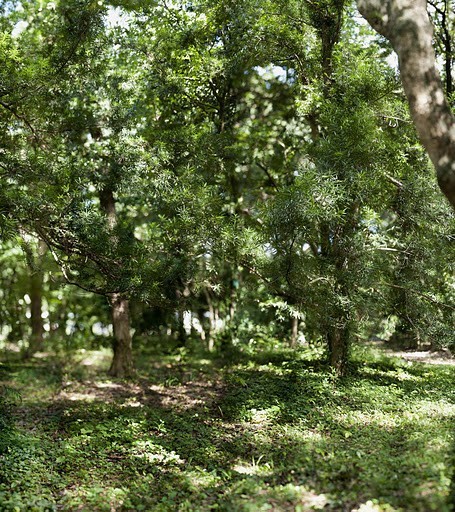
Naruki Oshima haptic green – pi.k.k.02 (2011), type C print, 135 x 120 cm, edition of 5. Courtesy Gallery Nomart.
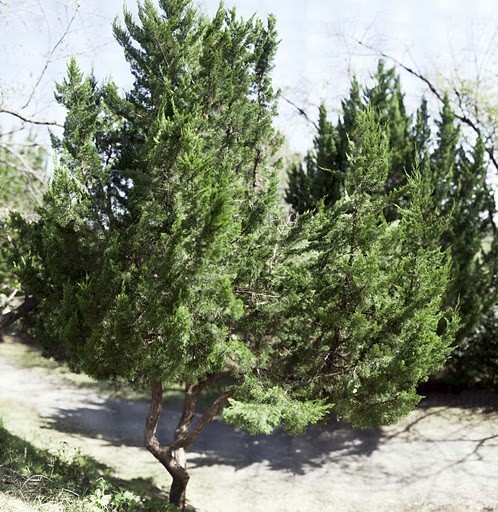
Naruki Oshima haptic green – ce.k.ma.01 (2011), type C print, 126 x 120 cm, edition of 5. Courtesy Gallery Nomart.
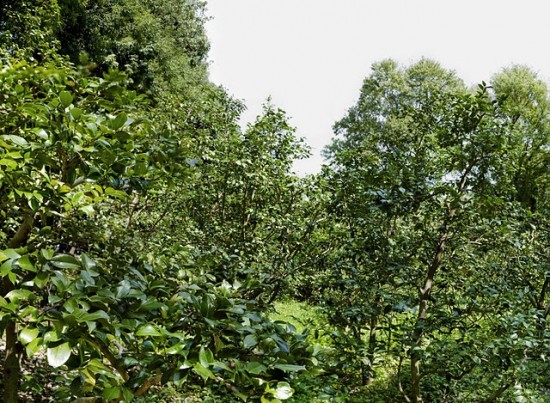
Naruki Oshima haptic green – ca.k.k.01 (2011), type C print, 120 x 155 cm, edition of 5. Courtesy Gallery Nomart.
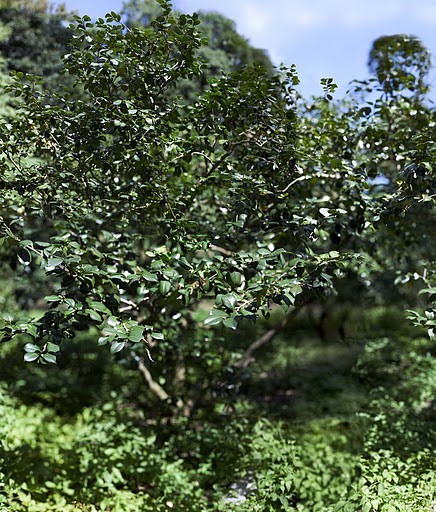
Naruki Oshima haptic green – ca.k.k.02 (2011), type C print, 141 x 120 cm, edition of 5. Courtesy Gallery Nomart.
Naruki Oshima’s “haptic green” was on display at Gallery Nomart, Osaka, from November 5 to December 3, 2011.
-
See Minoru Shimizu, “Pikutorializumu no genzai” (Pictorialism today) in Shashin to hibi (Photography and the everyday), (Tokyo: Gendaishichoshinsha, 2006).
- Maurice Merleau-Ponty, Phenomenologie de la perception, (Paris: Gallimard, 1945), trans Colin Smith under the title Phenomenology of Perception (London: Routledge & Kegan Paul, 1962; reprinted, 2003), p. 245.
- ibid, p. 310.
- ibid, p. 247.
- ibid, p. 249.
- Differential focusing is a process that produces layers (ie, surfaces) perpendicular to the axis of the direction in which the lens is pointed. In contrast to this, because in digital photography images are essentially captured as arrays of pixels (ie, points), whenever differential focusing is used, regardless of whether a digital camera is used or digital processing applied, the resultant works are not “digital.” The reason is that even though digital photography can mimic layers, its essence is not based on layers. Accordingly, as a means of nullifying layers as things that cut through “the thickness of the medium,” Oshima’s methodology is consciously perverted. How “haptic green” develops from here probably depends on what kind of non-layered use of digital photography can express “visual and tactile sensations.”
